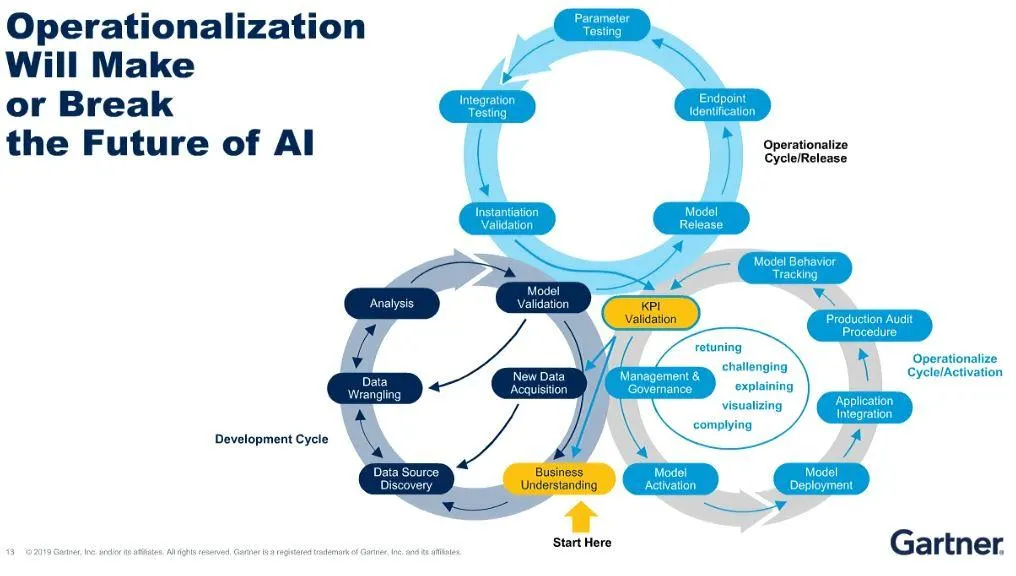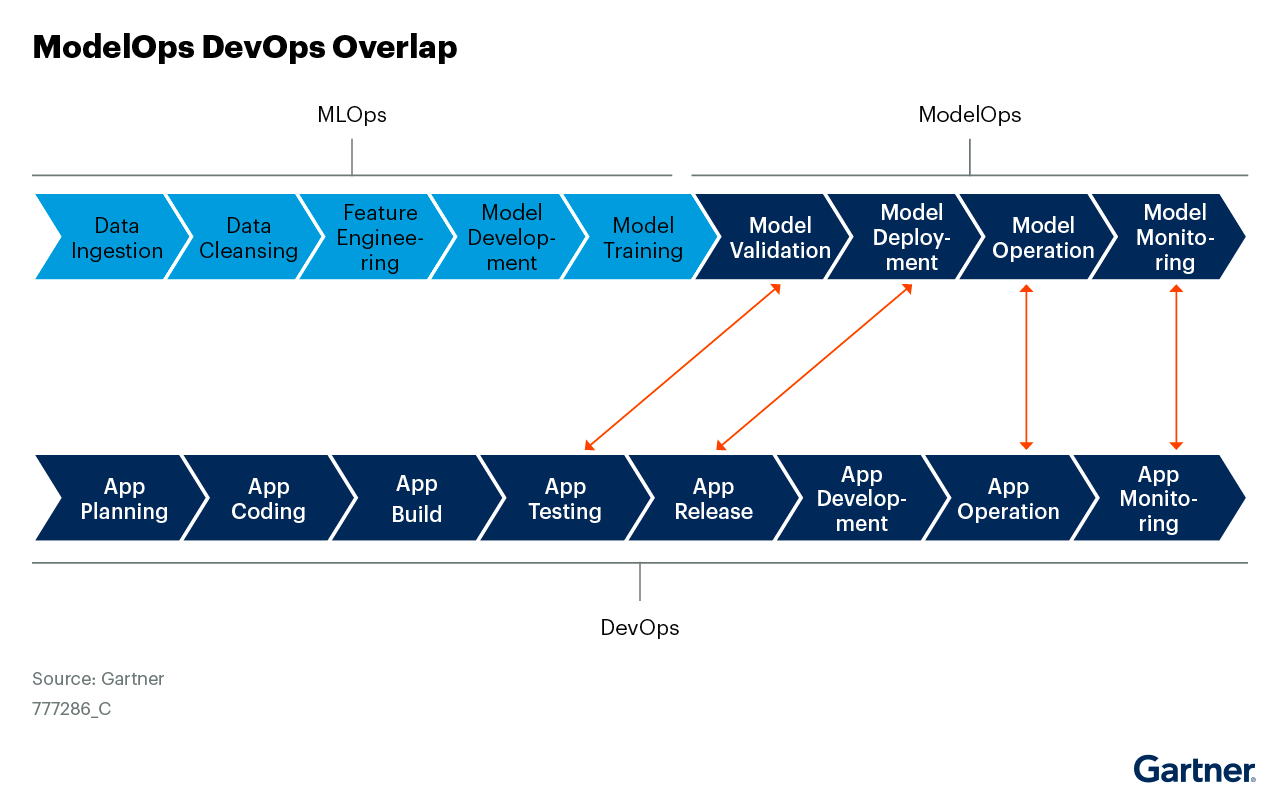January 2, 2024
The Critical Importance of ModelOps in AI Readiness
Building a generative AI proof-of-concept is relatively low cost. Scaling it and putting it into production at an enterprise level is a much different undertaking, requiring new capabilities, disciplines, and rigor. New frameworks for ensuring trustworthiness and preparedness are emerging to meet the needs of companies competing in the AI economy.
Model operationalization (ModelOps) encompasses all advanced analytics decisions within the organization, including your AI models. By standardizing, scaling, and augmenting analytics, information services companies will be best positioned to build products informed by governed, trustworthy data.
As the use of AI and ML models increases, software engineering leaders must:
- Ensure that their development team responsibilities are well-defined in relation to the data science teams
- Enable a portion of their developers to acquire the skills needed to manage elements of the ModelOps pipeline
- Define developers’ responsibilities for the elements of the ModelOps pipeline that overlap with the DevOps pipeline to support changes in application composition and integration of ongoing changes into production applications
Read on to see how ModelOps is key to effectively execute game-changing AI value that solves for customer needs.
What is model operationalization (ModelOps)?
ModelOps is a set of capabilities focused on governing and managing all AI and decision models. This includes models based on machine learning (ML), knowledge graphs, rules, optimization, natural language techniques and agents.
ModelOps is critical to building trustworthy data products that are continuously improving in performance, informed by governed, unbiased, trustworthy data, and producing insights for customers—internal and external.

In a nutshell, ModelOps helps organizations move models from lab environments into production with greater efficiency and fewer errors. This results in a range of business value:
- Foundation for management of various knowledge representation models, reasoning capabilities, and composite model integration
- Augmentation of the ability to manage decision models and integrate multiple analytics techniques for robust decision making
- Efficiency through accelerated development and deployment, as well as higher quality ML models, through a similar CI/CD practice that DevOps teams practice
- Scalability by enabling the monitoring and management of thousands of models, providing reproducibility of model pipelines, tightly-coupled collaboration, and fewer conflicts among teams
- Risk reduction by enabling greater transparency, faster response to issues, and greater compliance with company or industry policies
- Collaboration is enhanced as wider business functions integrate and work in tandem
As AI and ML model use grows, particularly in the enterprise space, software engineering teams must work with the data science teams that build AI and ML models for those enterprise applications. Engineers will need to accommodate factors like model retraining, model deactivation, and version rollbacks into their processes and workflows.
ModelOps vs. DevOps
Although there are many comparisons to be made between ModelOps and DevOps—and the two philosophies align at many points—there are some key differences between the two.

ModelOps and DevOps align on foundational concepts of collaboration, automation, and continuous improvement. Further, both disciplines focus on improving cross-functional collaboration.
However, ModelOps is more experimental in nature from DevOps, leading to some core differences:
- DevOps focuses on the overall software development process, while ModelOps focuses specifically on analytics and decision models and their deployment
- DevOps emphasizes collaboration and communication among the development, testing, and operations teams, while ModelOps emphasizes data management and model versioning
- DevOps prioritizes overall application performance, while ModelOps prioritizes model performance
At its core, ModelOps differs from DevOps primarily in scope and focus. So if your organization already implements DevOps principles in your product development lifecycle, shifting to ModelOps requires some more specific expertise in model development, but the underlying principles will be very similar.
Steps to success with ModelOps
ModelOps is not a static process, but an organizational proficiency that requires mastery over time. As such, your information services organization will likely not achieve core competence initially, but gradually over time.
Here’s a rough sketch of the ModelOps maturity growth curve. This should help you plot where you currently sit, and give you a roadmap for where you could go in the future.
ModelOps level 0: Everything is manual
The vast majority of AI and ML operations within companies sit at this base level, where manual workflows are the norm:
- Data scientists who build the model are disconnected from engineers who service it
- Data prep, model training, deploying, monitoring—all executed without automation
- No continuous integration or continuous deployment (CI/CD)
- New model versioning is deployed infrequently, and new models have a greater chance of failing to adapt to changes
It should seem obvious the risks of staying at this level. Even if you continue to develop proficiency in AI and ML capabilities, you’ll struggle translating that technical success into business success, as your organization will be disjointed and you have no way to prove the model’s value to the end user.
ModelOps level 1: Automated pipeline
As such, companies start to adopt automated ModelOps processes as they grow. By introducing a basic level of automation into your model processes, you start to loop in fresh data for continuous training. This will allow your model access to the most relevant information, significantly improving its prediction abilities.
ModelOps level 2: Automated CI/CD system
But there’s still another stage of ModelOps development—and that’s adopting a robust CI/CD system. At this stage, updates to the model are rapid, reliable, and retrained with fresh data. This system enables data scientists and engineers to operate collaboratively, with minimal disruption.
Achieving this level of ModelOps success is difficult if you don’t have the lifecycle management skill set within your organization. Many organizations look to outside resources—like product development partners—to provide the necessary, robust support.
Final thoughts on ModelOps in information services
For information services companies who want to achieve scalable success with generative AI and machine learning, ModelOps is a critical, table stakes business function. Without a framework to coordinate and integrate the various disciplines within your organization, it can be difficult to leverage AI/ML to open new revenue sources and increase organizational efficiency.
But no matter your competence with data science, infrastructure, and governance, without a holistic product mindset, you risk building applications that customers and users simply won’t engage with.
3Pillar Global is well-positioned to be your strategic advisor across the entire data lifecycle & ModelOps growth curve. We can help you figure out the most advantageous ways to scale your AI and ML products, finding new ways to drive transformational change and solve for customer needs.
Learn more about how 3Pillar Global can provide the support to build and grow with generative AI and machine learning. Contact us to get started today.
 The Revenue Cycle Playbook:
The Revenue Cycle Playbook: